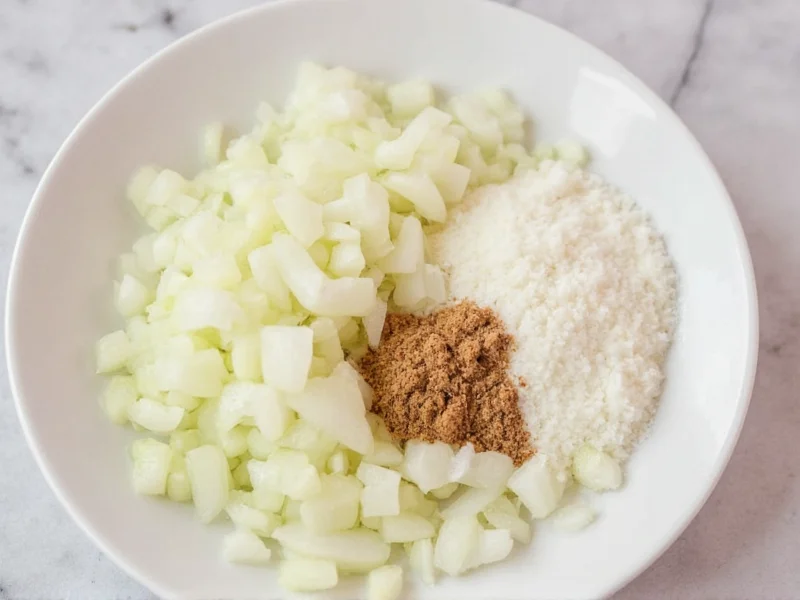Converting fresh ingredients to dried forms requires understanding moisture content and flavor concentration. When recipes call for chopped onions but you only have onion powder available, knowing the precise conversion ratio prevents flavor imbalances in your dishes. The standard culinary conversion follows a 3:1 ratio where fresh ingredients require three times the volume of their dried counterparts.
Understanding Onion Conversion Ratios
Onion powder contains significantly less moisture than fresh onions, resulting in concentrated flavor. During dehydration, onions lose approximately 90% of their water content, which explains why smaller quantities of powder deliver equivalent flavor.
| Chopped Fresh Onion | Onion Powder Equivalent |
|---|---|
| 1/4 cup (4 tablespoons) | 1 tablespoon |
| 1/2 cup (8 tablespoons) | 2 tablespoons |
| 3/4 cup (12 tablespoons) | 3 tablespoons |
| 1 cup (16 tablespoons) | 4 tablespoons (1/4 cup) |
Factors Affecting Onion Substitution Accuracy
Several variables influence how precisely your substitution will work in recipes:
- Onion variety - Yellow onions have stronger flavor than sweet varieties, affecting conversion intensity
- Moisture content - Freshly chopped onions release more liquid than drained or sautéed onions
- Powder quality - Finely ground powders distribute more evenly than coarser varieties
- Recipe type - Baking requires more precise measurements than simmered sauces
Best Practices for Substituting Onion Powder
When replacing fresh chopped onions with powder in recipes, follow these professional kitchen guidelines:
- Always start with slightly less powder than the conversion suggests, then adjust to taste
- Add powder early in cooking to allow flavors to distribute evenly
- Compensate for missing moisture by adding 1-2 teaspoons of water per tablespoon of powder
- Avoid substitution in raw applications like salads or salsas where texture matters
- For baked goods, sift powder with dry ingredients to prevent clumping
When Fresh Onions Work Better Than Powder
Certain culinary applications benefit from fresh onions rather than powder:
Texture-dependent dishes like stir-fries, fresh salsas, or onion rings require the crispness of fresh onions. Recipes where visual appeal matters—such as garnishes or layered casseroles—also perform better with fresh ingredients. The enzymatic reactions in raw onions create complex flavors that powder cannot replicate, making them essential for dishes like French onion soup where caramelization creates depth.
Practical Recipe Applications
Understanding 1/4 cup chopped onion to onion powder conversion proves valuable across multiple cooking scenarios:
When making meatloaf, substituting 1 tablespoon onion powder for 1/4 cup fresh chopped onions ensures consistent flavor without excess moisture that could affect texture. In dry spice rubs, onion powder integrates more smoothly than fresh onions. For quick weeknight meals, keeping onion powder on hand allows for instant flavor without prep time.
Professional chefs often combine both forms—using fresh onions for texture and bulk while adding a small amount of powder to boost overall onion flavor. This technique works particularly well in soups and stews where extended cooking time allows powder to fully hydrate.
Common Measurement Mistakes to Avoid
Many home cooks make critical errors when converting between fresh and dried onions:
Using equal volumes (1:1 ratio) creates overpowering flavor that dominates dishes. Forgetting to adjust liquid content leads to dry baked goods or thickened sauces. Adding powder too late in cooking prevents proper flavor distribution. Not considering the recipe's moisture requirements results in texture issues. Understanding these onion powder substitution guidelines prevents common kitchen disasters.
Advanced Conversion Techniques
For precision cooking, consider these professional techniques:
When exact conversion matters, weigh ingredients instead of measuring by volume. One ounce of fresh chopped onion equals approximately 0.1 ounces of onion powder. For critical applications like commercial food production, conduct small test batches to determine the ideal ratio for your specific ingredients and equipment. Remember that converting 1/4 cup fresh onion to powder works differently in acidic environments (like tomato sauces) versus neutral bases (like mashed potatoes).











 浙公网安备
33010002000092号
浙公网安备
33010002000092号 浙B2-20120091-4
浙B2-20120091-4